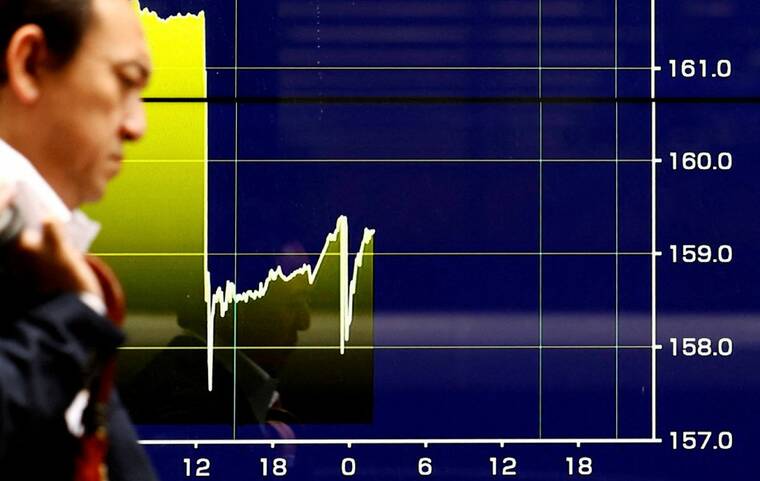Dollar edges higher on yen after Tokyo’s likely intervention

REUTERS/ISSEI KATO/FILE PHOTO
An electronic screen displays a graph showing yen exchange rates surging against the dollar amid an alert to the possibility of Japanese intervention in Tokyo, on July 12.
SINGAPORE/LONDON >> The dollar regained some lost ground on the Japanese yen today even as traders remained wary of further intervention by Tokyo to prop up their currency after data showed they likely stepped into markets late last week.
The dollar was last up 0.3% on the yen at 158.44. It had been trading just shy of 162 yen last week before sudden falls, which took it to as low as 157.16 on Thursday.
Bank of Japan data released today suggested Tokyo may have spent 2.14 trillion yen ($13.5 billion) by stepping into the money market on Friday.
Combined with the estimated amount spent a day earlier, Japan is likely to have bought nearly 6 trillion yen via intervention last week.
Japanese authorities have made it standard practice to not confirm whether they have intervened, but Chief Cabinet Secretary Yoshimasa Hayashi said Japan stands ready to take all possible steps to counter excessively volatile currency moves.
Moves in Europe were fairly calm as traders were nervous about placing too big bets on sterling ahead of crucial British inflation data due on Wednesday and on the euro, with a European Central Bank (ECB) meeting on Thursday.
Don't miss out on what's happening!
Stay in touch with breaking news, as it happens, conveniently in your email inbox. It's FREE!
The pound was last flat at $1.29685, having hit a near one-year high just shy of $1.3 a day earlier.
The euro too was little changed at $1.09003, just shy of a four-month high touched on Monday, having erased losses from the past few weeks when it came under pressure from uncertainty over the French election.
The ECB is expected to hold rates, but attention will be on comments from President Christine Lagarde on timing of the next rate cut.
Markets are pricing in 48 basis points (bps) more cuts from the ECB this year, after it cut rates by 25 bps in June.
“The key development, I think, will be if Lagarde hints at the prospect of another cut coming at the September meeting,” said Stuart Cole, chief economist at Equiti Capital.
He said though this was unlikely as “the ECB is looking for more signs that pricing pressures are abating before being confident enough to cut again”.
“Of course, what does make it easier for the ECB to cut is the growing likelihood of the Fed cutting in September too.”
On Monday, Federal Reserve chair Jerome Powell said the second quarter’s three U.S. inflation readings “add somewhat to confidence” that the pace of price increases is returning to the Fed’s target in a sustainable way.
The comments, likely Powell’s last until his press conference after a Fed meeting set for July 30 and 31, shifted rate cut expectations.
Markets now anticipate 68 bps of easing this year, with a rate cut in September fully priced in, the CME FedWatch tool showed.
U.S. retail sales for June due later in the day could further guide expectations for the Fed. They are expected to show a decline of 0.3% month-on-month.
Elsewhere, the Australian dollar was 0.26% lower at $0.6742, off a six-month high touched last week, and the Swiss franc was steady at 0.8956 per dollar and 0.9764 to the euro.
Cryptocurrencies, along with shares of companies that could benefit from a Trump presidency, jumped on Monday after an assassination bid on the Republican candidate boosted expectations that he would win the November election.
Bitcoin and Ether eased slightly today.



